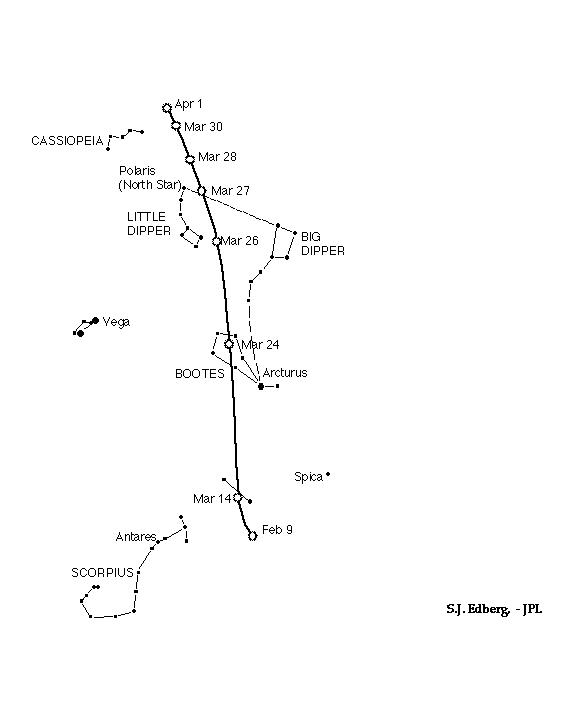
March 24-25, 1996: The night of Hyakutake's closest approach...the comet moves some 18 degrees or an average of 0.75 degrees an hour! Motion is obvious to the naked eye over several minutes. Through a small telescope, background stars seem to float past the comet. The comet's coma may be as much as two degrees or more in diameter. A faint tail will be visible in dark skies extending 10 - 20 degrees (or perhaps even more in binoculars). From the city, the comet appears like a large, strongly condensed (sharp brightening towards the center) fuzz ball. The comet starts the evening about 10 degrees from the end star of the Big Dipper's handle - above the handle. Over the night it moves six degrees further north. The comet should be at its brightest and largest during this night.
March 25-26, 1996: The comet will be located just off the Little Dipper's cup (or bowl) as it continues to move north and now to the west. Its brightness and size should remain near peak values.
March 26-27, 1996: The comet is sitting next to Polaris, the North Star, which will appear faint in comparison. The comet is just past its most northerly point and is heading south and west. The tail has swung around and is now pointing toward the east. The first quarter Moon is beginning to interfere with observing the comet. The best observing is after Moon set (1:05 AM).
March 27-28, 1996: The comet is now noticeably fainter and the tail has begun to shrink. The comet is situated about 15 degrees from Polaris, along the line from cup of the Little Dipper through Polaris. The Moon sets at 1:47 AM.
March 28-29, 1996: The comet is sitting on a line extended from Delta through Epsilon Cassiopeia (the two stars on the squashed end of Cassiopeia's W) about 10 degrees from east of Epsilon. The Moon sets at 2:47 AM.
March 29-30, 1996: The comet is now 10 degrees due east of Cassiopeia's W on the line from Gamma (the middle star in the W) to Epsilon Cassiopeia (the end star on the squashed end of the W). The comet is now a factor of six fainter than just five days ago. The comet's coma has also shrunk by a factor of two. The Moon sets at 3:03 AM.
March 30-31, 1996: This is the last night that the comet is circumpolar, never setting below a flat horizon, for Southern California. The only time to see the comet in a dark sky is to catch it at the beginning of morning twilight when the comet is less than seven degrees above the north-northeast horizon. The Moon sets at 3:39 AM.
April 1-4, 1996: The Moon interferes with viewing the comet. It should be noted that early in the evening of April 3rd, a lunar eclipse will be visible from the Eastern US. This will provide an opportunity to observe the comet in a darker sky. The Western US will not see the total phase of the eclipse and thus, it will not gain any advantage in viewing the comet.
April 5-26, 1996: The comet will be visible in the northwest sky (starting about 30 degrees off the horizon at the end of twilight) as a fuzzy star with a tail. The comet should fade at first, but by April 10th it will be brightening each night. The comet will be easier to pick out than in late March because the head will be smaller and the tail should be brighter. As it sinks lower towards the northwest horizon each night, the tail should grow brighter and longer. It is possible that the comet's head will equal the brightness of Sirius (low in the southwest after dark, the brightest star in the sky) by the 26th, and the tail could stretch 15 - 30 degrees in length. On the 26th, the comet will set at the end of astronomical twilight and thus, will not be visible in a totally dark sky. However, the tail may be visible after the comet's head has disappeared below the horizon. The comet will remain visible for two or three more days in bright twilight before disappearing for good (for the Northern Hemisphere) in the Sun's glow.
This is the pridicted trend for the comet. Actual observations may differ in bahavior, but overall, the comet should be very visible for a while.

 |
 |
 |